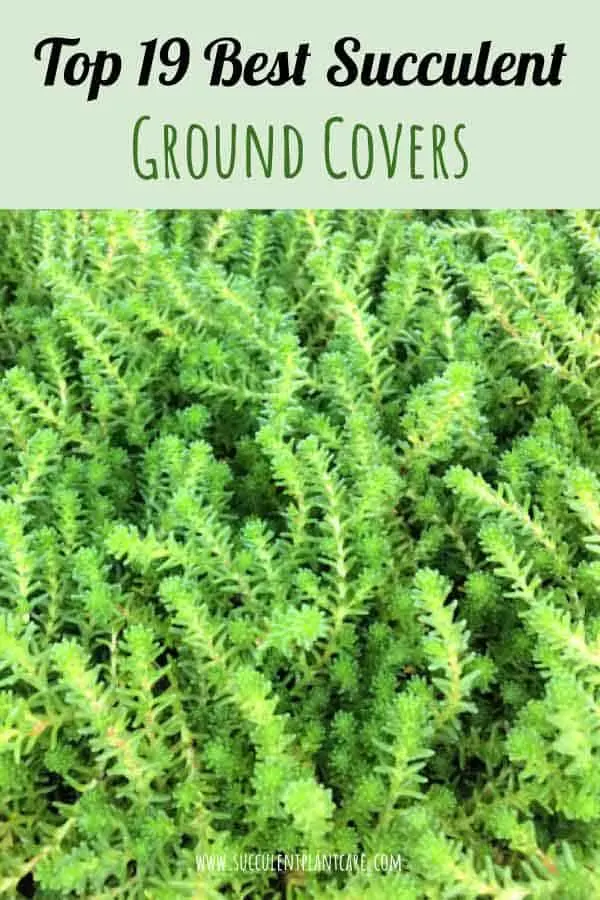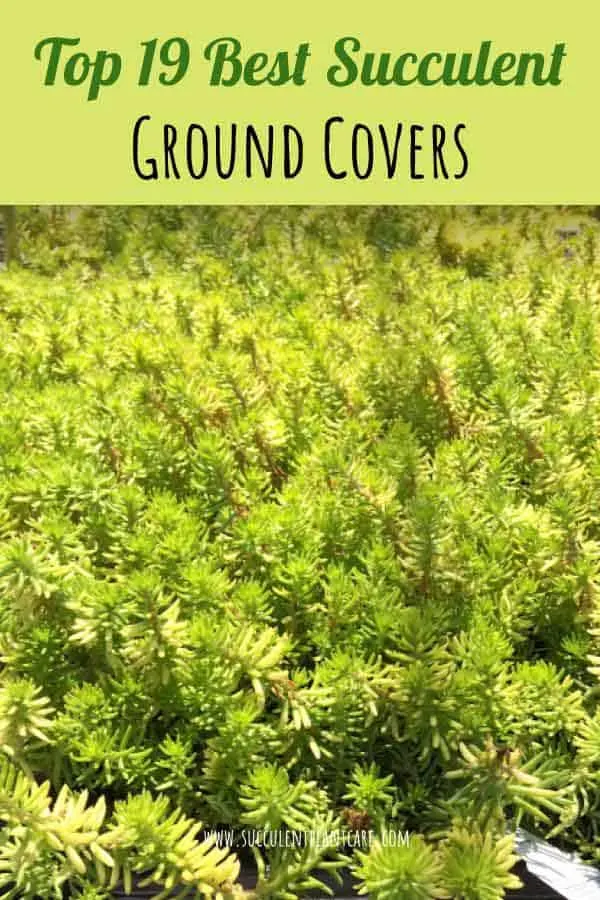Thinking of using succulents as ground cover? Why not? Succulents are very versatile plants. They do well in containers as well as planted in the ground.
Succulents make excellent ground covers due to their easy going and drought tolerant nature. They come in different shapes, colors and textures to bring beauty and practicality to any landscape.

The Top 19 Best Succulent Ground Covers Are:
Sedums
Sedums or stonecrops are low growing, evergreen perennials that make excellent groundcovers. They spread out and sprawl vertically as they grow. Sedums are low maintenance plants and require very little attention and care.
Sedums thrive in different lighting conditions but prefer very bright light. They can tolerate full sun once acclimated. They are able to withstand heat with very little precipitation. Some are also frost hardy, making them an excellent choice for ground cover plants.
Some popular sedum ground covers are:
Sedum Spurium ‘Dragon’s Blood Stonecrop’
Sedum Spurium ‘Dragon’s Blood Stonecrop’, aka ‘Red Carpet’ is commonly used as ground cover because of its cold hardy nature. They are one of the cold-hardiest sedums out there. The color of the leaves turns from green to reddish-purple to a deep burgundy depending on the season and lighting conditions. They produce star-shaped bright pink-reddish flowers. They can grow up to 3-6 inches (1.18-2.36cm) tall.

Sedum Reflexum ‘Blue Spruce or Blue Stonecrop’
Also known as Petrosedum rupestre (Common names: Blue Stonecrop, Blue Spruce, Jenny’s Stonecrop) have blue-green foliage that turns light green to yellow with pinkish overtones in the winter and under full sun. These are low growing succulents that can grow up to 3-5 inches (1.18-1.97 cm) tall. These are cold hardy sedums that can withstand freezing temperatures and snow, which make them a great choice for ground cover.

Sedum Japonicum ‘Tokyo Sun’
Low-growing and low maintenance sedum with lime green to bright yellow foliage. The sun brings out the yellow color of the plant. Under shade, the plant turns lime green. Grows to about 3 inches (1.18cm) tall. Tends to spread outwards as it grows. These will add a pop of color anywhere you place them. They are not as cold hardy as the other two sedums. Will tolerate mild frost but needs protection from extreme winter conditions.

Sempervivums
Sempervivums ‘Hens and Chicks’ come in different varieties of colors and sizes. They do best in full sun or bright light. Sempervivums multiply by growing clusters of small babies around the mother plant, giving them their common name ‘hens and chicks’. Some sempervivums can grow very large, while some remain tiny. They can be grown in containers or in the ground and can tolerate a wide range of growing conditions making them ideal ground covers.
Some Sempervivums that are great as ground covers are:
Sempervivum Arachnoideum ‘Cobweb Hens and Chicks’
Characterized by white hairs resembling cobwebs covering the surface of the plant. Fleshy green rosettes that turn burgundy at the base of the plant in winter. These are very low growing plants that can tolerate full sun and freezing temperatures.
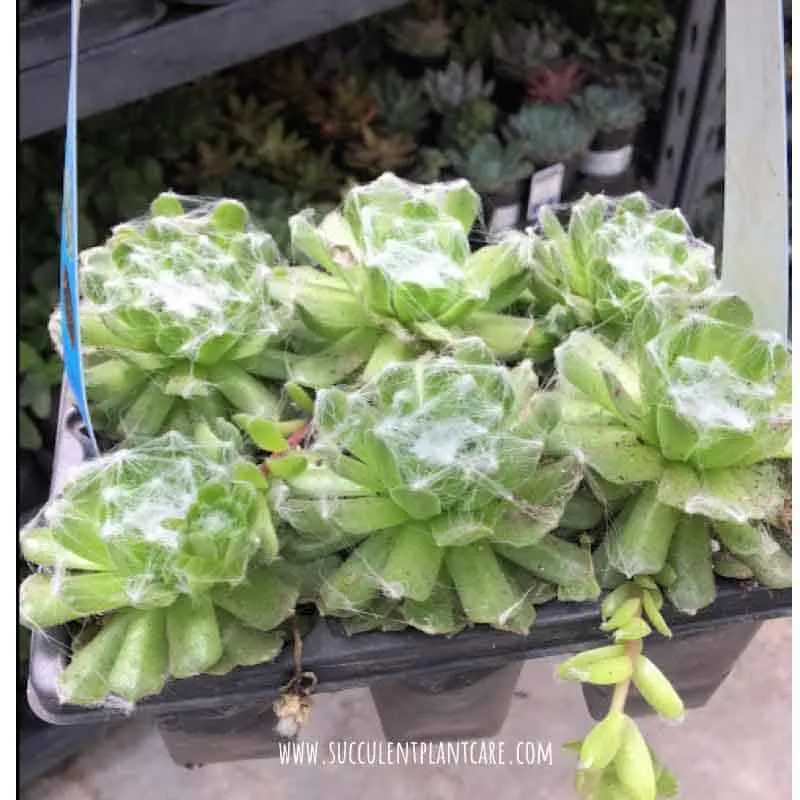
Sempervivum ‘Moss Rose’
Attractive rosettes with light green leaves and a hint of magenta. Tiny, soft hairs line the edges of the leaves. These can grow up to about 6 inches (2.36 cm) tall and 12 inches (4.72 cm) wide. Prefers bright light to full sun and can withstand freezing temperatures.
Sempervivum Calcareum ‘Fire Dragon’
These are known for their striking rosettes that are blue green in color with wine colored tips. Can grow upto 4-6 inches (1.57 to 2.36 cm) in diameter. These are low maintenance plants that prefer bright light to full sun. Can withstand heat as well as freezing temperatures.

Agaves
Agave is a large genus of succulent plants. Their distinguishing features are their rosette shapes and pointy leaves. Agave species vary widely; some are dwarf species and others are huge plants capable of growing up to 10 feet (3 meters) tall. They do not require much care and will thrive in different conditions and climates, from light shade to full intense sun. Some species are more cold-hardy than others.
Agaves that make great ground covers are:
Agave ‘Blue Glow’
These agaves form solitary rosettes and stay fairly small, making them ideal garden plants. Prefers plenty of sunlight to full sun and can withstand frost. Their distinctive look is their wide blue-green leaves edged with reddish margins. Can grow up to 1-2 ft (30-60cm) tall and 2-3 ft (60-90 cm) wide.
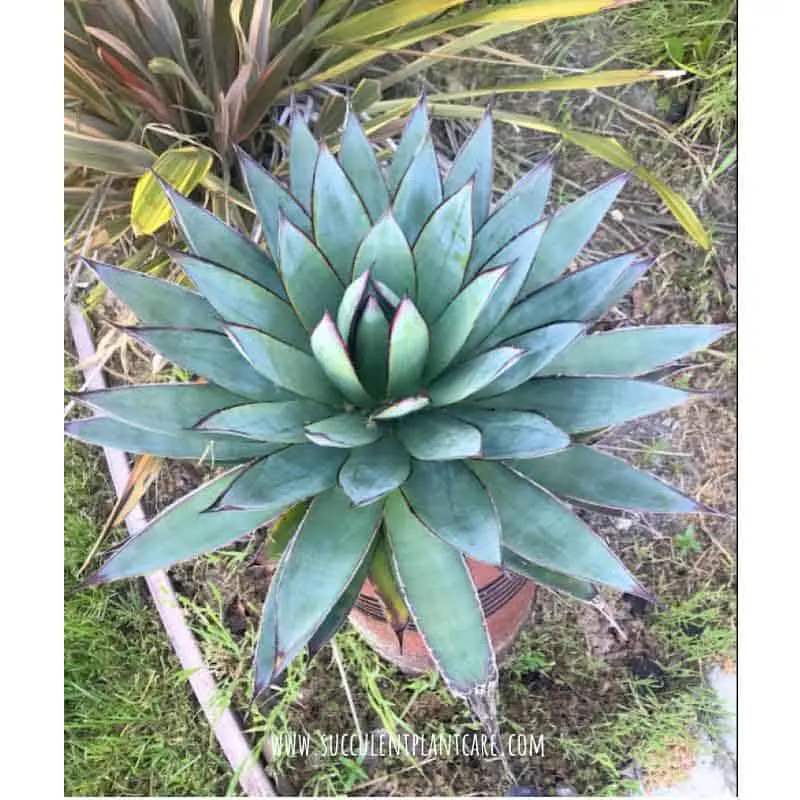
Agave Victoriae-Reginae ‘Queen Victoria Agave’
Attractive, compact agave with geometrical green rosettes lined with white markings. They stay small to medium size and are also slow growing so they won’t take over your entire garden space. They grow to about 1 ft (30 cm) tall and 1-2 ft (30-60cm) wide. Likes plenty of sun and can withstand mild frost.

Agave Titanota ‘Rancho Tambor Agave’
Small agave that grows as a solitary rosette so the pups won’t take over your yard. These have silvery blue-green leaves that are thick and wide with teeth on the edges. They can grow up to about 2 ft (60 cm) tall and 5-6 inches (12.7-15 cm) wide. Needs plenty of sun and can withstand mild frost.
Aloe
Aloe is a large and popular genus consisting of small dwarf species and large tree-like species growing up to 30 feet (10m). They have thick, fleshy, green to bluish-grey-green leaves. Most larger aloe species will do well in full sun and can be planted outdoors as landscape plants or in large containers. Some large species will tolerate mild frost with little to no damage to the plant. These are low maintenance plants that require very little care and attention.
Aloe Suitable as Ground Cover:
Aloe Cameronii ‘Red Aloe’
Native to Malawi and Zimbabwe, Aloe cameronii is a medium sized aloe that grows up to 1-2 ft (30-60 cm) tall and 2-4 ft (60-121 cm) wide. Leaves stay light green in the shade and when given plenty of water. Leaves turn coppery red in full sun and very little water. Can stay red all year when exposed to full sun. Aloe cameronii will brighten up any landscape with its colorful rosettes and bright flowers. Cold hardy up to 20°F (-6.67°C).
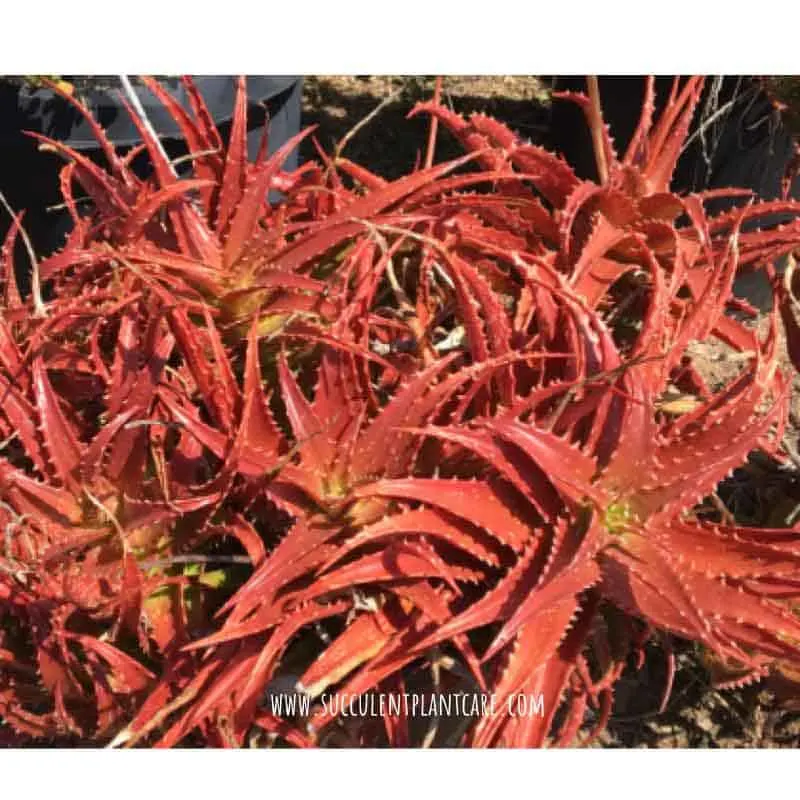
Aloe Nobilis ‘Gold Tooth Aloe’
Native to South Africa, these form clusters of attractive rosettes that can spread to 1-2 ft (30-60 cm) wide. They make an attractive ground cover with their pretty rosettes and brightly colored blooms. They have lime green leaves with white teeth along the edges that appear sharp but are actually pliable when touched. Leaves turn orange-red under intense heat or full sun. These are heat tolerant, drought resistant and cold hardy up to 20°F (-6.67°C) making them a good choice as ground cover for small and large spaces.
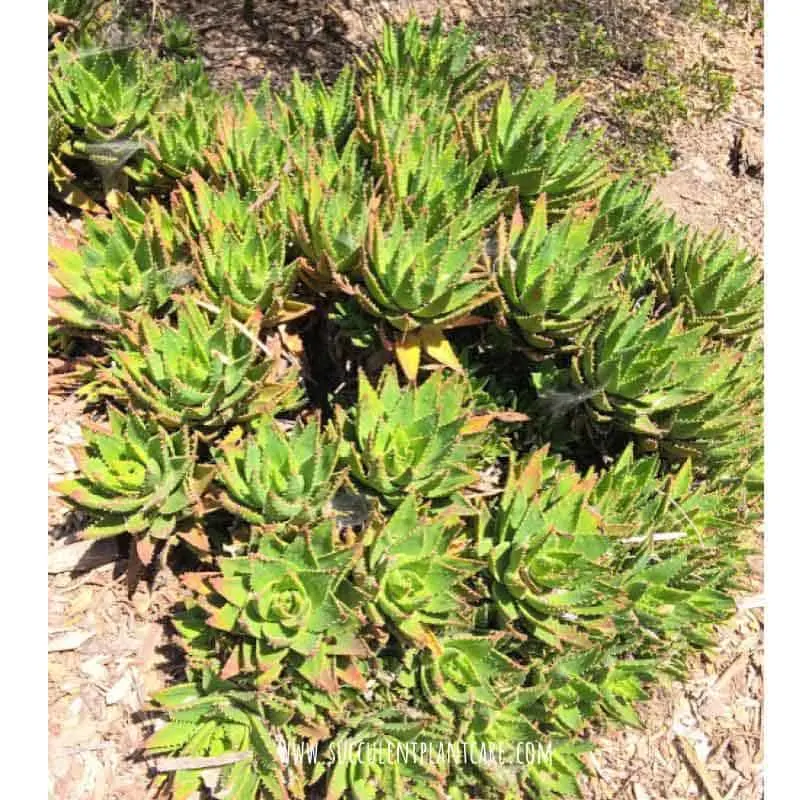
Aloe Humilis ‘Spider Aloe’
Aloe Humilis (Spider Aloe) is hardier than most small aloes and can tolerate periods of frost. Native to South Africa, aloe humilis has pale, blue-green leaves with white teeth along the edges. They are low growing plants and grow in small clusters that can get up to 12 in (30cm) wide. These are low maintenance, easy going plants that can withstand long periods of neglect which make them good candidates for ground cover plants.
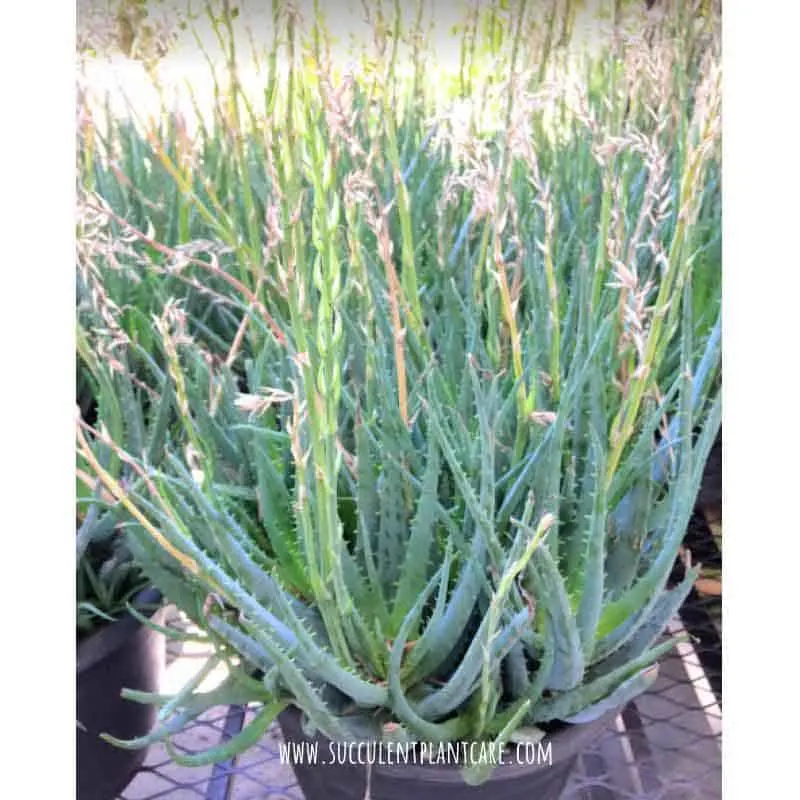
Crassula
Crassula is a large genus of succulent plants that come in an extensive array of colors, shapes and sizes. Most crassula species are highly adapted to growing in harsh environments and can withstand a wide range of growing conditions which make them ideal ground cover.
Crassulas that make great ground cover are:
Crassula Muscosa ‘Watch Chain’ or ‘Lizard’s Tail’
Native to South Africa, these are low growing, creeping and branching succulents that can grow up to 12 inches (30 cm) tall. They sprawl and spread outwards as they grow. They have attractive foliage that is light green in color and are tightly compacted around the stem forming a chain-like appearance. Can tolerate partial shade to full sun and is hardy up to about 20°F (-6.67°C). They produce small yellow-green flowers.
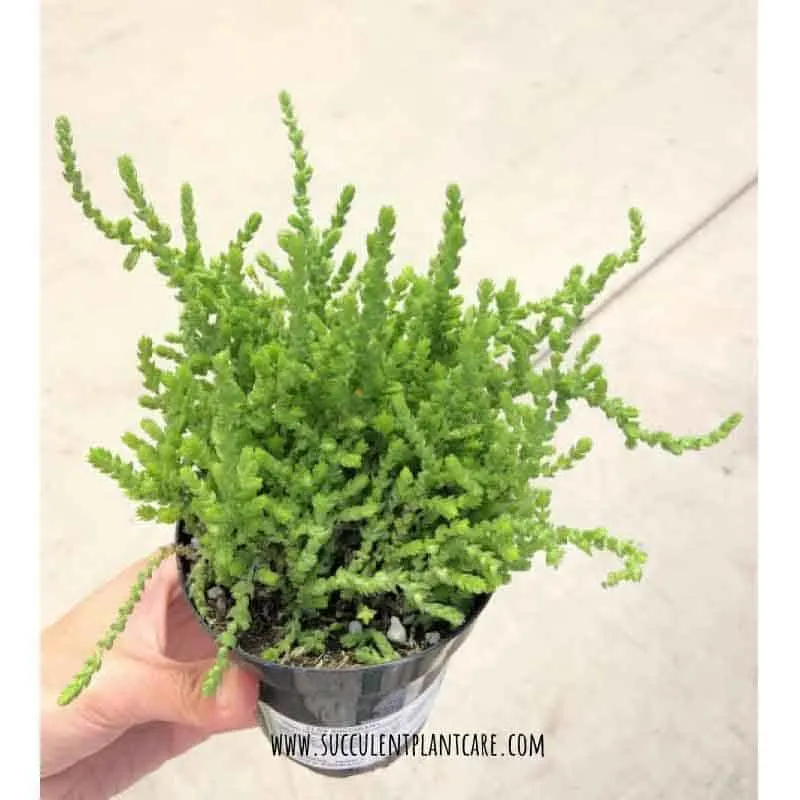
Crassula Capitella ‘Campfire Crassula’ or ‘Red Pagoda’
Also known as Crassula erosula, this is a low growing, branching and creeping succulent that only grows up to 5 inches (12.7 cm) tall. It has very attractive foliage with long leaves that stay lime green in the shade. Foliage turns to different shades of red and purple when exposed to sun and the cold. Will do well in areas that receive partial shade. Hardy up to 20°F (-6.67°C).
Crassula Multicava ‘Fairy Crassula’
An evergreen succulent that can grow up to 12 inches (30 cm) tall. Provides a dense carpet of lustrous foliage in different shades of green. Flowers are small, star-shaped and usually pink in color. Can tolerate a wide range of lighting conditions from shady to full sun. Drought resistant and hardy up to 20°F (-6.67°C).
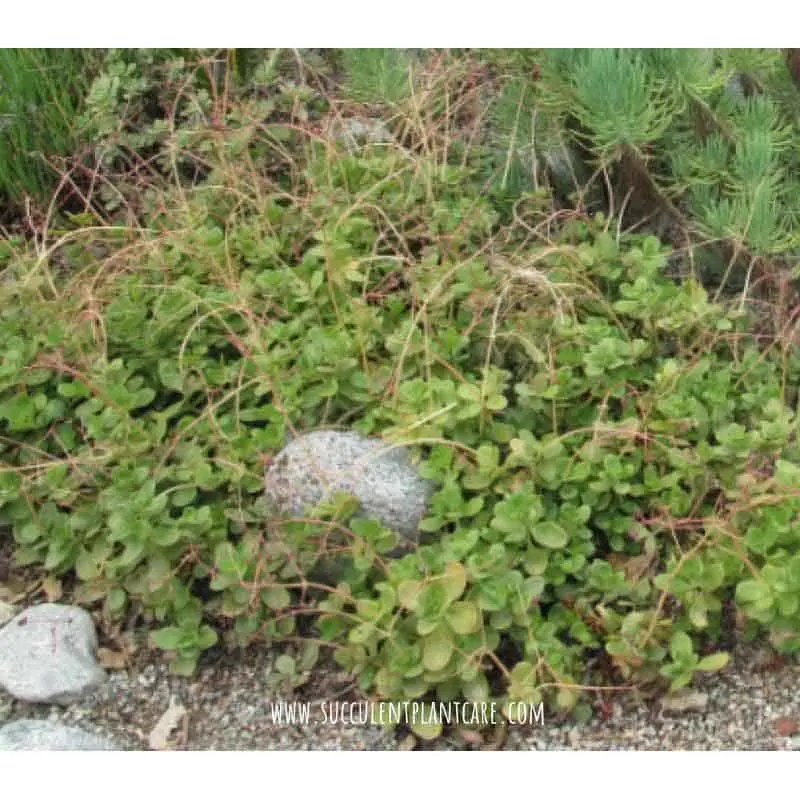
Euphorbia
Euphorbia is a very large genus of flowering plants with over 2,000 members. Euphorbia is also commonly referred to as spurge. Euphorbias are tough, hardy plants that are highly adaptable to different growing environments. Keep in mind that euphorbia sap is toxic and can be poisonous when ingested. The sap of the plant can cause skin irritation.
Some euphorbias suitable as ground covers are:
Euphorbia Myrsinities ‘Donkey Tail Spurge’
An evergreen, perennial succulent plant with stems that sprawl and trail. The leaves are blue-green in color and appear to spiral on top of each other, giving the plant an interesting shape and texture. Looks great planted in the ground or in containers. The plant produces attractive, bright yellow-green flowers that turn to red as they mature. Prefers bright light to full sun. Cold and drought resistant. Hardy in USDA zones 4-8.

Euphorbia Milii ‘Crown of Thorns’
Native to Madagascar, these succulents have highly adapted to different growing environments. They can be grown indoors as well as in ground. They can grow up to 2-3 feet (60-90 cm) tall. They produce attractive red or pink flowers.These plants are covered in sharp thorns about ½ inch long. The name, ‘Crown of Thorns’ comes from the biblical story of Christ’s crucifixion and identifies the plant as the mock crown placed on Jesus’ head at the crucifixion. They can tolerate different lighting conditions from shady to full sun. These are hardy in USDA zones 9-11.

Euphorbia Rigida ‘Upright Myrtle Spurge’
Native to the Mediterranean, Euphorbia Rigida (Upright Myrtle Spurge or Silver Spurge) is an evergreen perennial with blue-gray leaves that spiral around the stem. In the fall and colder months, the foliage turns brownish red at the tips. They form beautiful pale green to yellow flowers from the top of the leaves. Can grow up to 1-2 ft (30-60 cm) tall and shrub-like in appearance. Prefers bright light to full sun. Hardy in USDA zones 7-10.
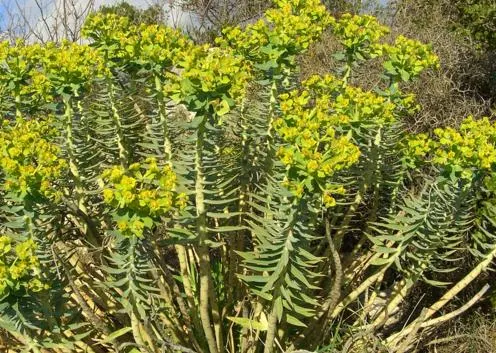
Senecio Serpens ‘Blue Chalksticks’
Native to South Africa, these are low growing succulents that spread out as they grow. They have attractive silvery blue-green leaves that are long and pointy. These are popular ground covers in USDA hardiness zones 9-11. Needs protection from extreme winter conditions. Prefers plenty of sunlight and will tolerate full sun.

The succulents mentioned above make great ground cover because they are easy going, hardy, tough plants that can withstand harsh growing conditions. They require very little care and attention but will add beauty and dimension to your garden space.
While highly adapted to the heat, they can still burn under the intense summer heat or during a heat wave. You can protect your plants from the extreme heat by providing sunshades. Here are some of my sunshade recommendations. While these succulents can withstand frost, some are more cold hardy than others. You can protect them from freezing temperatures outdoors by using frost cloths and covers. Here are some of my frost protection recommendations.
Where can you find these succulents? Check out my resource page for recommendations on where to purchase these online.
Pin this to save for later or share with others now!
